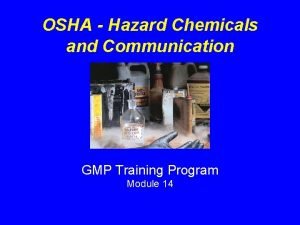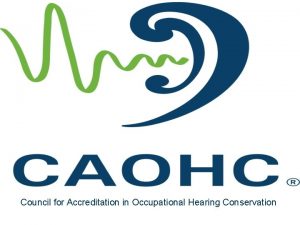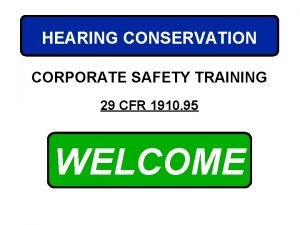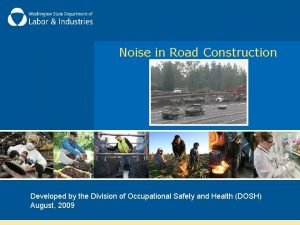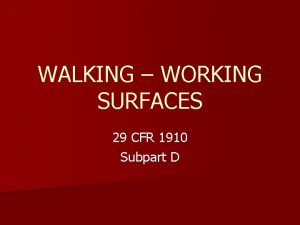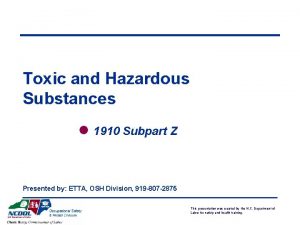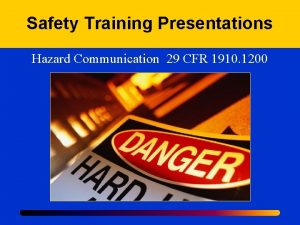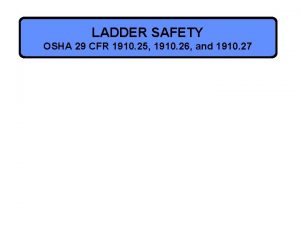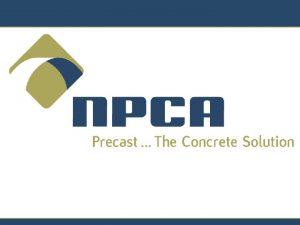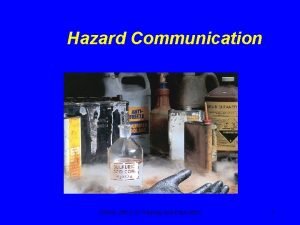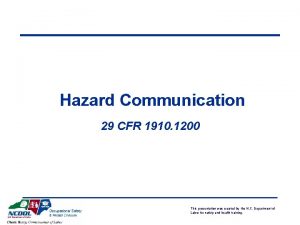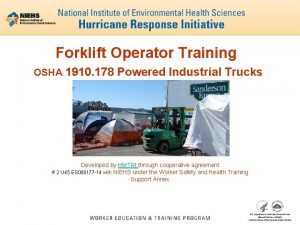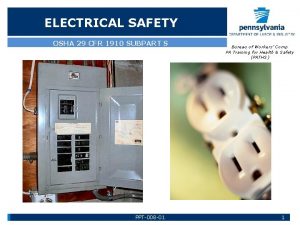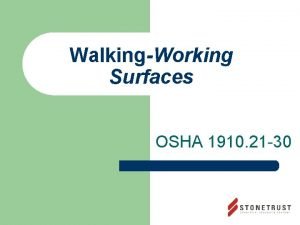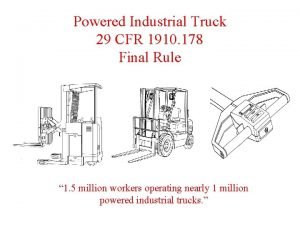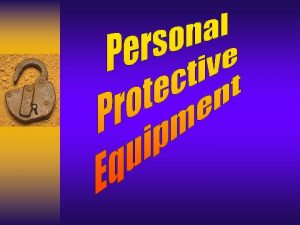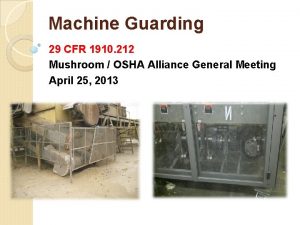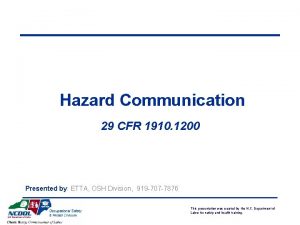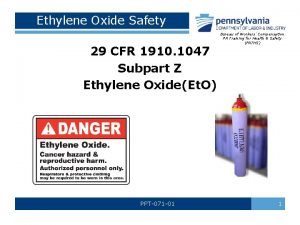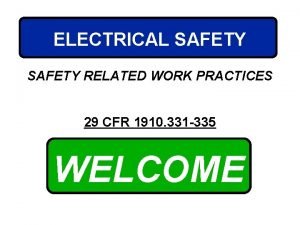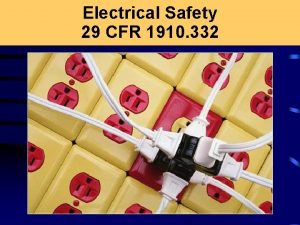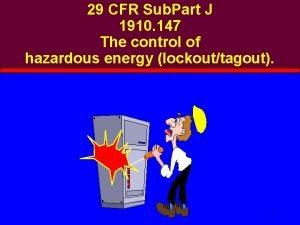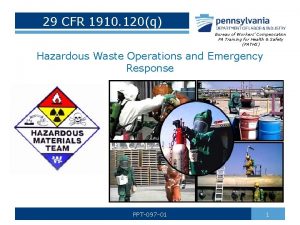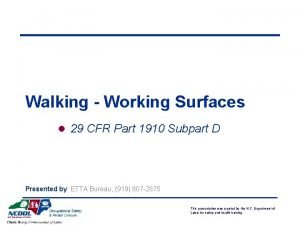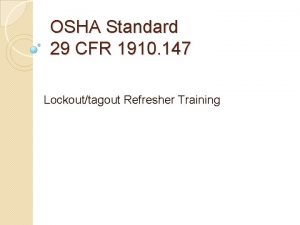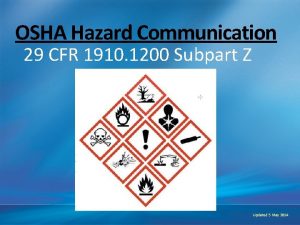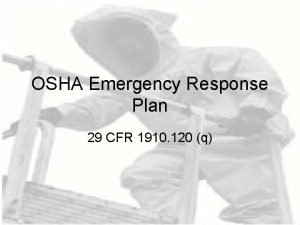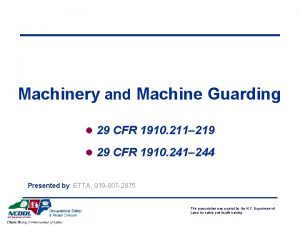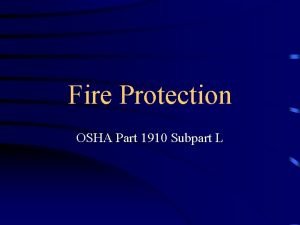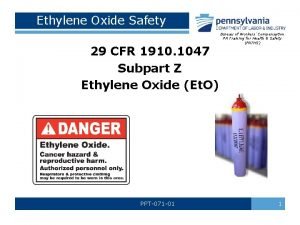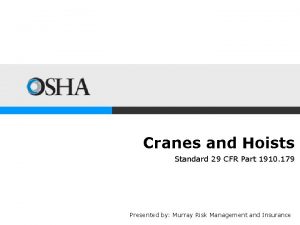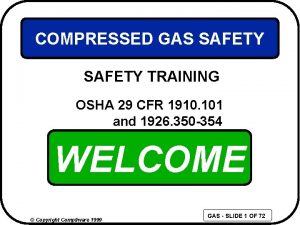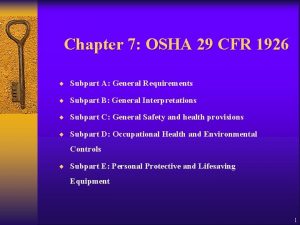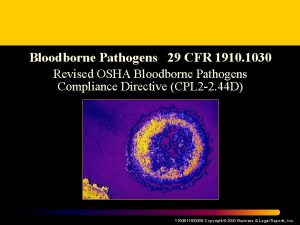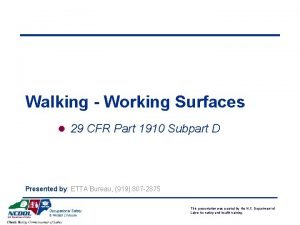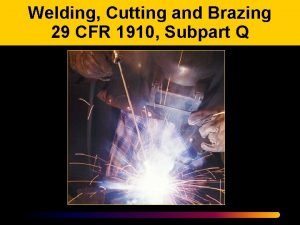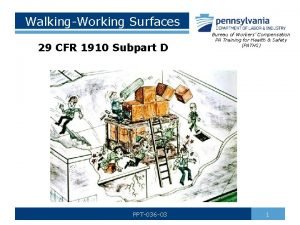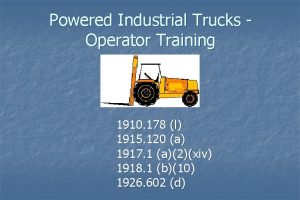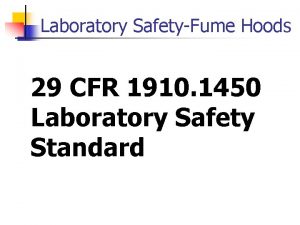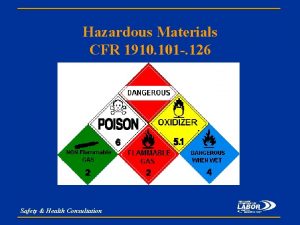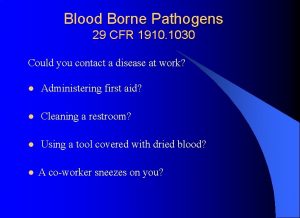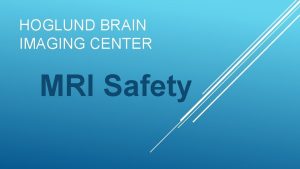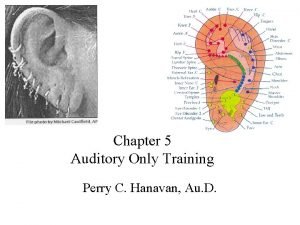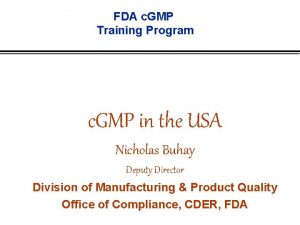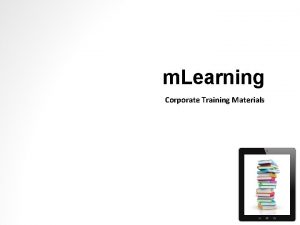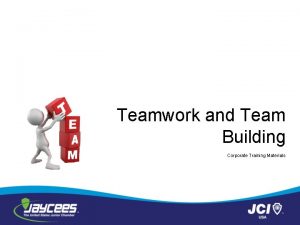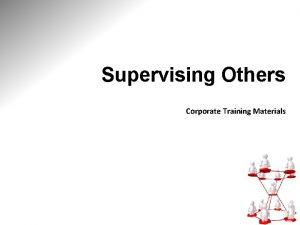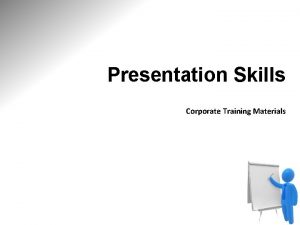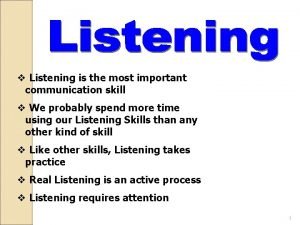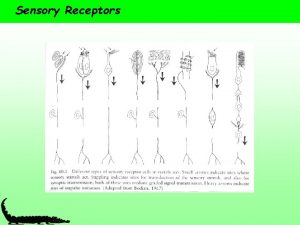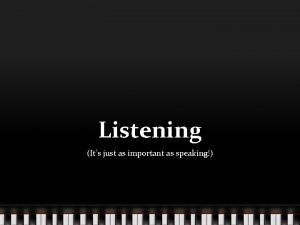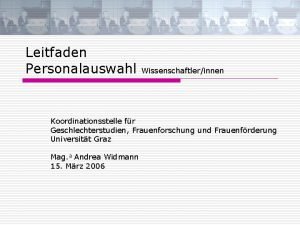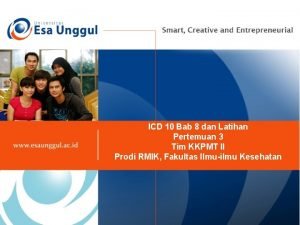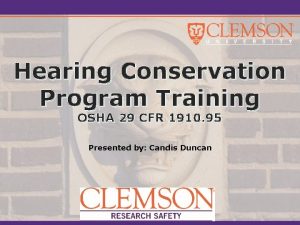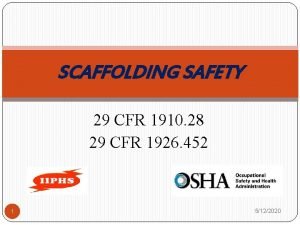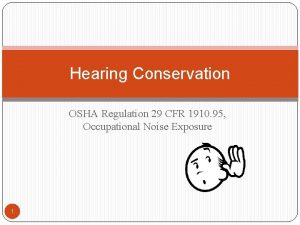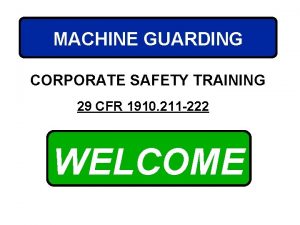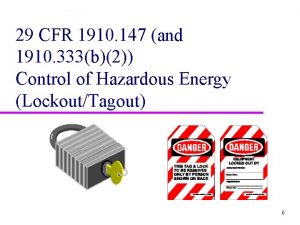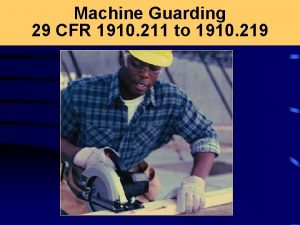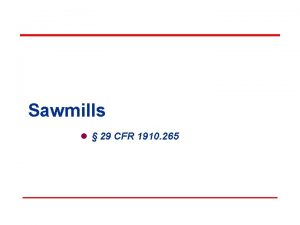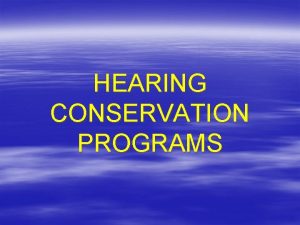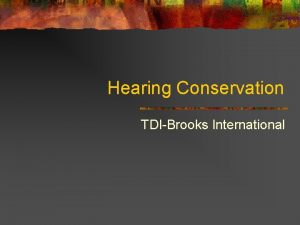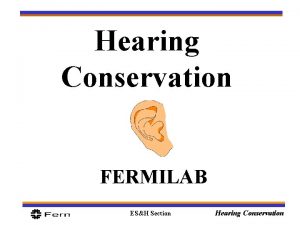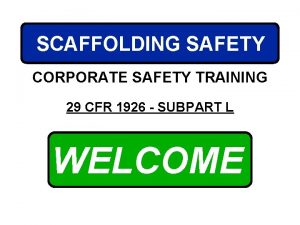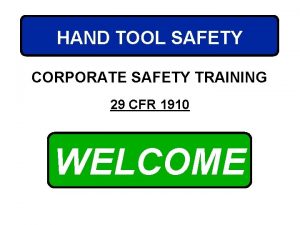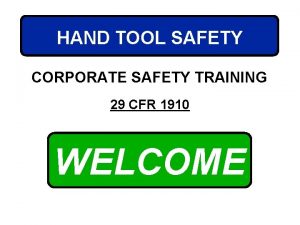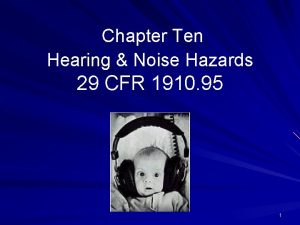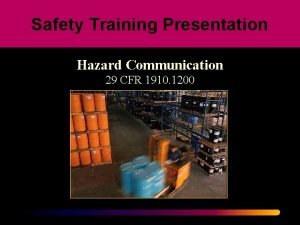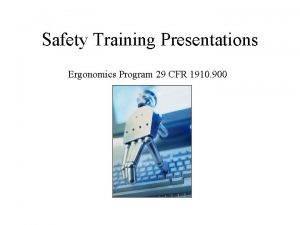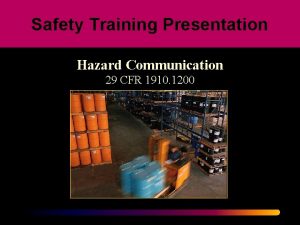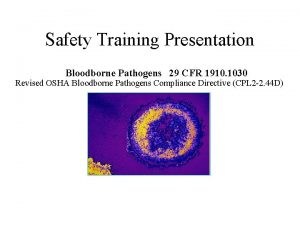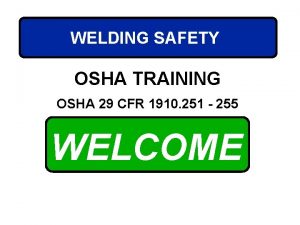HEARING CONSERVATION CORPORATE SAFETY TRAINING 29 CFR 1910



































































- Slides: 67

HEARING CONSERVATION CORPORATE SAFETY TRAINING 29 CFR 1910. 95 WELCOME

COURSE OBJECTIVES þ Discuss Hearing Program Requirements. þ Discuss The Types of Hearing Protection. þ Discuss Hearing Protection Selection Criteria. þ Discuss Hearing Protection Assessment Techniques. þ Discuss Basic Skills in Hazard Recognition & Control. þ Discuss OSHA’S Requirements for Hearing Protection. þ Discuss Hearing Protection’s Role in Today’s Industry. þ Discuss Industrial Hazards Requiring Hearing Protection.

APPLICABLE REGULATIONS 29 CFR - SAFETY AND HEALTH STANDARDS 1910 - INDUSTRIAL SAFETY 95 - OCCUPATIONAL NOISE EXPOSURE

APPLICABLE REGULATIONS CONTENTS OF 29 CFR 1910. 95: þ þ þ þ þ a. b. c. d. e. f. g. h. i. j. A-Weighted Sound Level Determination Permissible Noise Exposures Program Requirements Monitoring Requirements Employee Notification Observation of Monitoring Audiometric Testing Program Audiometric Testing Requirements Hearing Protector Attenuation

APPLICABLE REGULATIONS (Continued) CONTENTS OF 29 CFR 1910. 95: þ þ k. Training Program l. Access to Information and Training Materials m. Recordkeeping n. Appendices A - Noise Exposure Computation B - Estimating Hearing Protection Attenuation C - Audiometric Measuring Instruments D - Audiometric Test Rooms E - Acoustical Calibration of Audiometers F - Age Correction Calculations For Audiograms G - Monitoring Noise Levels H - Availability of Referenced Documents

GENERAL PROGRAM REQUIREMENTS ALL EMPLOYERS MUST: þ Establish a Written Program þ Conduct Audiometric Testing þ Address Noise Exposure Standards þ Conduct Regular Program Evaluations þ Conduct Work Area Noise Surveillance þ Conduct Hearing Conservation Training þ Control Hazards Using Ear Protectors as a Last Resort þ Ensure Proper Selection of Noise Exposure Equipment

TRAINING REQUIREMENTS THE EMPLOYER MUST PROVIDE TRAINING: þ þ þ þ þ Training Must Establish Proficiency in use of Protectors. Explain The Operation, Capabilities, and Limitations. Training Must be Conducted Prior to Job Assignment. Explain The Reason Hearing Protection is Needed. Explain Why a Hearing Protector has been Selected. Explain Proper Maintenance and Storage of Protectors. Explain Inspection, and Proper Wear. Explain The Nature, Extent and Effects of Noise Hazards. Provide Explanation of Why Engineering Controls are not in Use.

RETRAINING REQUIREMENTS REQUIRED WHEN THERE IS A: þ þ þ Program Related Injury. Change in Job Assignment. New Hazards or Equipment. New Hazard Control Methods. Failure in the Safety Procedures. Reason to Doubt Employee Proficiency.

HEARING CONSERVATION TRAINING IS IMPORTANT A GOOD PROGRAM WILL HELP: þ Reduce injury and illness rates. þ Acceptance of high-turnover jobs. þ Workers feel better about their work. þ Reduce workers’ compensation costs. þ Elevate OSHA compliance to a higher level.

HEARING CONSERVATION TRAINING PREVENTION “It is estimated that in the United States, 97% of the money spent for medical care is directed toward treatment of an illness, injury or disability. Only 3% is spent on prevention. ” Self-help Manual for your Back H. Duane Saunders, MSPT by Educational Opportunities

PROGRAM IMPLEMENTATION OF A HEARING CONSERVATION PROGRAM REQUIRES: þ DEDICATION þ PERSONAL INTEREST þ MANAGEMENT COMMITMENT NOTE: UNDERSTANDING AND SUPPORT FROM THE WORK FORCE IS ESSENTIAL, WITHOUT IT THE PROGRAM WILL FAIL!

PROGRAM IMPLEMENTATION Continued DEVELOPMENT SEQUENCE: þ þ þ þ þ Establish responsibility. Establish a corporate policy and develop rules. Conduct a noise survey of the facility. Determine appropriate noise control measures. Eliminate noise hazards where possible. Conduct employee training. Provide protection where hazard elimination is not possible. Perform inspections and maintenance. Periodically audit the program. Modify policies and rules as appropriate.

PROGRAM IMPLEMENTATION Continued DEVELOPMENT SEQUENCE: þ The initial goal should be to reduce or eliminate noise hazards by: 1. 2. 3. 4. 5. 6. Elimination or substitution of noise producing sources. Insulating equipment to lower noise levels. Implementation of administrative controls. Implementation of engineering controls. Issuance of hearing protection equipment. Providing training and procedures.

IMPLEMENTATION STRATEGY Continued $ RECOGNITION @ EVALUATION 4 IMPLEMENTATION þ CONTROL

IMPLEMENTATION STRATEGY Continued þ RECOGNITION ASSESSMENT OF NOISE HAZARDS: ü Known jobs/areas having high noise sources. ü Known jobs/areas requiring noise protection. ü Jobs/areas having had recent operational changes. ü Jobs/areas with new equipment or processes. ü New jobs having little or no statistical injury data.

IMPLEMENTATION STRATEGY Continued $ RECOGNITION @ EVALUATION 4 IMPLEMENTATION þ CONTROL

IMPLEMENTATION STRATEGY Continued þ EVALUATION ü Facility audit data. ü Employee surveys. ü Accident investigations. ü Industrial Hygiene surveys. ü Logs of employee complaints. ü Organizational structure development. ü Statistical evidence of known/potential hazards. ü Injury and illness data of known/potential hazards.

IMPLEMENTATION STRATEGY Continued $ RECOGNITION @ EVALUATION 4 IMPLEMENTATION þ CONTROL

IMPLEMENTATION STRATEGY Continued þ IMPLEMENTATION ü Written program. ü Training program. ü Employee involvement. ü Supervisor involvement. ü Corrective action program. ü Job hazard analysis program. ü Organizational structure establishment. ü Safety in purchasing (new equipment, products ect. )

IMPLEMENTATION STRATEGY Continued $ RECOGNITION @ EVALUATION 4 IMPLEMENTATION þ CONTROL

IMPLEMENTATION STRATEGY Continued þ CONTROL ü ü ü ü ü Periodic facility audits. Written program reviews. Industrial Hygiene surveys. Employee feedback surveys. Job hazard analysis reviews. Recurrent training programs. Supervisor feedback surveys. Periodic statistical evaluations. Corrective action follow-up measures.

IMPLEMENTATION STRATEGY Continued þ CONTROL MEASURES CONSIDERATIONS: ü ü ü ü Capital improvement plan to eliminated hazards. Costs involved in implementing control measures. Length of time necessary for implementation. Level of urgency in implementation. Compatibility with existing controls. Cost of hearing protection equipment. Anticipated problems with employee use.

IMPLEMENTATION STRATEGY Continued þ PRIORITIZATION CONSIDERATIONS: ü ü ü Severity of injuries as a result of hazards. Consequences of an injury at the worksite. Likelihood that the operation will have an injury. The length of exposure to the hazard. Long-term effects of noise exposure.

KEY PROGRAM ELEMENTS INCLUDE: 1. Noise Exposure Monitoring 2. Engineering and Administrative Controls 3. Audiometric Evaluation 4. Use of Hearing Protection Devices 5. Training and Motivation 6. Recordkeeping 7. Program Evaluation

KEY PROGRAM ELEMENTS (Continued) þ NOISE EXPOSURE MONITORING ü Define Survey Goals ü Characterize the Hazard Accurately - Area Surveys - Noise Dosimetry - Engineering Surveys ü Ensure Results are Representative ü Identify Affected Employees ü Evaluate Specific Noise Sources ü Prioritize Noise Control Efforts

KEY PROGRAM ELEMENTS (Continued) þ ENGINEERING AND ADMINISTRATIVE CONTROLS ü ü ü Reducing Reverberation and Echo's Reducing Structure-borne Vibrations Initiate Physical Changes at the Noise Source Modify or Replace of Equipment Physical Changes in the Transmission Path Examples Include: - Sound Absorbing Material - Mufflers on Noise Sources - Acoustical Enclosures and Barriers - Vibration Mounts and Proper Lubrication

KEY PROGRAM ELEMENTS (Continued) þ AUDIOMETRIC EVALUATION ü Should be Performed: 1. Pre-employment 2. Prior to Initial Work Assignment 3. Annually if the Employee Stays in the Same Job 4. At Reassignment Out of a Noisy Job 5. At the Termination of Employment ü Employees Who are Not Noise Exposed can be Tested to Provide a Comparison Group to Determine the Overall Effectiveness of the Program. The Two Groups should Show the Same Amount of Audiometric Change if the Program is Effective.

KEY PROGRAM ELEMENTS (Continued) þ AUDIOMETRIC EVALUATION (Continued) ü Must be administered with calibrated equipment ü Testing must have acceptable background sounds levels ü The same type of audiometer should be used year to year ü Only accredited technicians should be used ü Standardized testing methods should be used ü An Audiologist or Physician should supervise testing

KEY PROGRAM ELEMENTS (Continued) þ TYPES OF HEARING PROTECTION DEVICES ü Ear Muffs (Circumaural) ü Semi-Inserts (Semi-Aural) ü Inserts (Aural) Each type has advantages and disadvantages

KEY PROGRAM ELEMENTS (Continued) þ TRAINING AND MOTIVATION ü ü ü Employees “are” the program Job-specific training is essential Annual recurrent training recommended Active employee participation is essential Training is essential to employee motivation Training needed for: - Managers - Supervisors - Affected employees - Maintenance personnel

KEY PROGRAM ELEMENTS (Continued) þ RECORDKEEPING ü ü ü ü ü Purpose of the examination Specific equipment used and calibration dates Name of the tester Date and time of the test Auditory history information The hearing threshold values obtained Tester’s judgment of the subject’s response reliability Record of any refitting, reissuing, or retraining Tester’s comments, if any

KEY PROGRAM ELEMENTS (Continued) þ RETENTION OF RECORDS ü Noise exposure measurement records - 25 years ü Audiometric test records - Duration of employment

KEY PROGRAM ELEMENTS (Continued) þ PROGRAM EVALUATION ü Two basic approaches - Evaluate the program’s components - Evaluate the audiometric data

PROGRAM REVIEW & EVALUATION TECHNIQUES INCLUDE: þ þ þ Noise surveys (area and personal) Job hazard analysis assessments. Employee surveys. Review of results of facility evaluations. Analysis of trends in injury/illness rates. Up-to-date records of logs of noise hazard improvements tried or implemented. þ Before and after surveys/evaluations of job/worksite noise protection changes.

WRITTEN PROGRAM þ WRITTEN PROGRAMS MUST BE: ü DEVELOPED ü IMPLEMENTED ü CONTROLLED ü JOB SPECIFIC ü UNDERSTANDABLE ü SUFFICIENTLY DETAILED ü PERIODICALLY REVIEWED

THE SUPERVISOR’S ROLE þ CONSIDER THE FOLLOWING: 1. GET INVOLVED IN THE HAZARD ASSESSMENTS. 2. OBTAIN ASSISTANCE (IF NEEDED) FROM EXPERTS IN THE FIELD OF CONCERN. 3. COMPLETE THE PAPERWORK (WORK ORDERS, POLICY CHANGES, ETC. ) TO MAKE CORRECTIVE ACTIONS. 4. ATTEND THE SAME TRAINING AS YOUR WORKERS. 5. FOLLOW-UP ON THE ACTIONS YOU TOOK.

HEARING PROTECTION SITUATIONS WORK INVOLVING: þ þ þ þ þ Chain saws Construction Lawn mowing Sand blasting Jack hammers Spray painting Musical performances Grinders, lathes, saws Manufacturing operations Exposure during maintenance duties

PRINCIPLES OF HEARING OUTER EAR - MIDDLE EAR - INNER EAR AUDITORY NERVE HAMMER ANVIL STIRRUP COCHLEA EAR CANAL EAR DRUM EUSTACHIAN TUBE

PRINCIPLES OF HEARING Continued þ THE COCHLEA AND THE INNER EAR ü ü A fluid filled sound reception chamber Contains thousands of tiny hair cells The cells respond to sound waves made in the fluid The cells pass the sensation on to the auditory nerve

PRINCIPLES OF HEARING Continued þ SENSORI-NEURAL HEARING LOSS ü ü Noise-induced hearing loss Damages the hair cells or auditory nerves If the noise is stopped hair cells can bounce back Damage can be temporary

PRINCIPLES OF HEARING Continued þ SENSORI-NEURAL HEARING LOSS ü If the noise continues hair cells can’t bounce back ü Damage can be permanent!

PRINCIPLES OF HEARING Continued þ NOISE MEASUREMENT ü Decibel (d. B) - A unit of measurement for sound pressure ü 085 Decibels (d. B) is max for the average workday ü 140 Decibels (d. B) is max for impulse or impact noise No exposures in excess of 140 d. B peak sound pressure level are permitted. Impulsive or impact noise is considered to be those variations in noise levels at intervals of greater than one per second. Where the intervals are less than one second, it should be considered continuous. Source: ACGIH

PRINCIPLES OF HEARING Continued þ NOISE MEASUREMENT (Continued) ü Sound is measured in two ways: 1. Frequency Intensity 2. Intensity Frequency

PRINCIPLES OF HEARING Continued FREQUENCY: The pitch -- how high or low the sound is. Expressed in cycles per second (CPS). Most people can hear pitches between 20 CPS and 20, 000 CPS.

PRINCIPLES OF HEARING Continued INTENSITY: The loudness of sound. Expressed in units called decibels (d. B). the more d. B’s, the louder the sound. One decibel in the smallest unit of sound a person can hear.

PRINCIPLES OF HEARING Continued NOISE REDUCTION RATING (NRR): A single number measure of the amount of attenuation of sound that a hearing protection device will reduce outside sound to. Expressed in units of decibels (d. B). 85 d. B NRR 40 d. B 45 d. B

PRINCIPLES OF HEARING Continued THRESHOLD LIMIT VALUE The TLV is the upper limit of noise as measured in decibels averaged over an eight hour work day to which an average healthy person may be repeatedly exposed on an all-day, everyday basis without suffering adverse hearing loss. American (ACGIH). Conference of Governmental Industrial Hygienist MMMM M MM

PRINCIPLES OF HEARING Continued þ THRESHOLD SHIFT ü Hearing loss caused from noise can raise your “hearing-threshold” -- the degree of loudness at which you first begin to hear sound. Two types of shifts can occur: 1. Temporary threshold shift 2. Permanent threshold shift

PRINCIPLES OF HEARING Continued þ TEMPORARY THRESHOLD SHIFT ü ü Most of the loss occurs in the first two hours Workers may not hear sound under 40 db after work Hearing “returns” within two hours after exposure stops The loss can become permanent with long exposure NOISE

PRINCIPLES OF HEARING Continued þ PERMANENT THRESHOLD SHIFT ü ü Usually no physical signs Early signs may be tinnitus, ringing, muffling of sound Hearing no longer “returns” within two hours The loss starts in high frequencies and may spread NOISE

PRINCIPLES OF HEARING Continued þ WORK SOURCES & FACTORS AFFECTING HEARING: ü ü ü ü ü Age Pitch Loudness Surroundings Type of machines Position of source Length of exposure Previous ear trouble Distance from source Think about your personal work habits!

PRINCIPLES OF HEARING Continued þ HOME SOURCES & FACTORS AFFECTING HEARING: ü ü ü ü ü Chain saws Race tracks Air hammers Trap shooting Starting pistols Musical groups Stereo systems Mowing the lawn Think about your personal lifestyle!

PRINCIPLES OF HEARING Continued HOW LOUD IS LOUD? SOURCE DECIBELS Rocket launching pad Jet plane Gunshot blast Jackhammer Automobile horn Sandblasting Rock music Chain saw Lawnmower 180 db 140 db 130 db 120 db 112 db 110 db 100 db 090 db

PRINCIPLES OF HEARING Continued HOW LOUD IS LOUD? SOURCE DECIBELS Alarm clock Busy traffic Vacuum cleaner Normal conversation Dishwasher Average home Quiet office Whisper at 5 feet Average threshold of hearing 080 db 075 db 070 db 065 db 060 db 050 db 040 db 030 db 015 db

PRINCIPLES OF HEARING Continued þ EXTREMELY HIGH, LOUD NOISE ü Can cause “Traumatic Hearing Loss” - May be caused by a single exposure to loud noise - Less common than other types of hearing damage ü Can cause other effects in the work place - Contributes to poor communication at work - Unpleasant sound may cause fear, anger etc. - Noise may cause fatigue or distractions MMMM M MM

PRINCIPLES OF HEARING Continued þ WHEN IS NOISE TOO LOUD? M M You have to raise your voice to be heard. You can’t hear someone less than 2 feet away from you. Speech sounds muffled after you leave a noisy area. You have ringing in your ears after exposure to noise. - American Speech-Language-Hearing Association MMMM M MM

HEARING DEVICE SELECTION AN INDUSTRIAL HYGIENIST SHOULD BE CONSULTED REGARDING THE TYPE OF HEARING PROTECTION TO BE USED WITH YOUR OPERATION! THE FOLLOWING ARE GENERAL GUIDELINES ONLY!

HEARING DEVICE SELECTION Continued þ TYPES OF HEARING PROTECTION DEVICES ü Ear Muffs (Circumaural) ü Semi-Inserts (Semi-Aural) ü Inserts (Aural) Each type has advantages and disadvantages

HEARING DEVICE SELECTION Continued þ EAR MUFFS (CIRCUMAURAL) ü ü ü ü Surround the ear to reduce sound Very effective at reducing sound One size usually fits everyone Can be expensive Cleaning can be time-consuming Bulk can be a problem Can be uncomfortable in hot conditions Can be attached to: - Helmets - Bump caps - Hard hats

HEARING DEVICE SELECTION Continued þ SEMI-INSERTS (SEMI-AURAL) ü ü ü ü ü Insert partially into the ear Snug fit is essential Moderately effective at reducing sound Do not always effectively seal ear canal One size fits all Large variety of shapes Cleaning is simple Bulk is not a problem Comfortable in hot conditions

HEARING DEVICE SELECTION Continued þ INSERTS (AURAL) ü ü ü ü ü Training is essential to proper use Insert into the ear Snug fit is essential Moderately effective at reducing sound Do not always effectively seal ear canal Large variety of shapes Cleaning is simple Bulk is not a problem Comfortable in hot conditions

HEARING DEVICE SELECTION Continued þ INSERTS (Available in three forms) Continued ü Premolded Inserts - which may be universalfitted or sized. ü Custom Molded Inserts - which are either fabricated at a factory from an impression taken of the ear canal or designed so that the impression itself becomes the final device. ü User Molded Inserts - which may be reusable or disposable, expand in the ear canal to form a seal after they are rolled and inserted.

HEARING DEVICE SELECTION Continued þ SELECTION CONSIDERATIONS ü ü ü Continued Will they effectively reduce sound levels? Comfort - will the users wear them? Cost Ease of use and repair Sizing and fitting ranges Dielectric considerations Training and skill for use Durability and life expectancy Anthropometric considerations Availability of replacement parts Size, weight, pressure, adjustability

HEARING DEVICE SELECTION Continued þ SELECTION CONSIDERATIONS ü ü ü Continued Visibility Pilferability Storage shelf life Climatic susceptibility Susceptibility to abuse Hygienic considerations Will the users like them? Susceptibility to alteration Confined space considerations Work environment susceptibility Compatibility with other equipment

INSPECTION AND CARE OF HEARING PROTECTION EQUIPMENT Continued HEARING DEVICE CHECKLIST: þ þ þ þ þ Do a fit test to ensure proper seal. Receive proper training in its use. Provide proper care for equipment. Ensure hazard levels are known. Review noise exposure limits. Receive annual and recurrent training. Select correct hearing protection devices. Follow local policies and procedures. Wear only approved hearing protection devices. Wear only devices on which you have received training.

INSPECTION AND CARE OF HEARING PROTECTION EQUIPMENT Continued INSPECTION CONSIDERATIONS: þ þ þ þ Develop a detailed inspection policy. Document each inspection. Inspect all components before use. Tag as unusable, damaged equipment. Inspect equipment before each use (without exception). Separate damaged equipment from serviceable equipment. Consider the effects on equipment stored for long periods. Remove contaminated equipment from service immediately.

INSPECTION AND CARE OF HEARING PROTECTION EQUIPMENT Continued CLEANING AND DISINFECTING CONSIDERATIONS: þ þ þ Read the manufactures guidelines first! Disassemble (if needed) in accordance with procedures. Scrub devices in detergent and warm water. Rinse to remove detergent. Air-dry, do not dry rubber under heat or sunlight. Never use solvents to clean plastic or rubber. STORAGE CONSIDERATIONS: þ Protect from sunlight, heat, cold, moisture and chemicals! þ Place devices in individual sealable plastic bags
 Osha hazard and ghs training regulation cfr 1910
Osha hazard and ghs training regulation cfr 1910 Caohc certification courses
Caohc certification courses Hearing conservation program audit checklist
Hearing conservation program audit checklist Hearing conservation program dosh
Hearing conservation program dosh D3ladder
D3ladder Osha z tables
Osha z tables Hazard communication safety training quiz answers
Hazard communication safety training quiz answers Osha 1910 forklift
Osha 1910 forklift Osha ladder safety 1910
Osha ladder safety 1910 29 cfr 1910 1200
29 cfr 1910 1200 Osha cfr 1910 is the standard for______.
Osha cfr 1910 is the standard for______. 29cfr1910.1200
29cfr1910.1200 29 cfr 1910 osha 178
29 cfr 1910 osha 178 Cfr 1910 subpart s
Cfr 1910 subpart s Osha 1910 housekeeping
Osha 1910 housekeeping 29 cfr 1910 osha 178
29 cfr 1910 osha 178 29 cfr 1910 ppe
29 cfr 1910 ppe 29 cfr 1910
29 cfr 1910 29 cfr 1910
29 cfr 1910 Osha 1910 forklift
Osha 1910 forklift 29cfr1910.1020
29cfr1910.1020 Osha 1910 electrical panel clearance
Osha 1910 electrical panel clearance 29 cfr 1910
29 cfr 1910 1910 147
1910 147 29 cfr1910.120
29 cfr1910.120 29 cfr 1910
29 cfr 1910 1910 147
1910 147 29 cfr 1910 section 1200
29 cfr 1910 section 1200 Osha 1910 120
Osha 1910 120 29 cfr 1910
29 cfr 1910 Osha 1910 subpart l
Osha 1910 subpart l 49 cfr 1910
49 cfr 1910 29 cfr part 1910
29 cfr part 1910 29 cfr 1910 compressed gas cylinder storage
29 cfr 1910 compressed gas cylinder storage Osha 1926 subpart c
Osha 1926 subpart c Bloodborne pathogens standard 29 cfr 1910
Bloodborne pathogens standard 29 cfr 1910 29 cfr part 1910
29 cfr part 1910 29 cfr 1910 subpart q
29 cfr 1910 subpart q Osha 29 cfr 1910 subpart d
Osha 29 cfr 1910 subpart d 29 cfr 1910 osha 178
29 cfr 1910 osha 178 29 cfr 1910 ppe
29 cfr 1910 ppe 29 cfr 1910 osha 178
29 cfr 1910 osha 178 29 cfr 1910.
29 cfr 1910. Compressed gas association pamphlet p-1-1965
Compressed gas association pamphlet p-1-1965 29cfr1910 1200
29cfr1910 1200 29 cfr 1910 1030
29 cfr 1910 1030 Hoglund brain imaging center
Hoglund brain imaging center Clearworks audiology
Clearworks audiology Safety care 2 person stability hold
Safety care 2 person stability hold Conservation of corporate finance
Conservation of corporate finance Objective of corporate finance
Objective of corporate finance 21 cfr 211 training requirements
21 cfr 211 training requirements Corporate learning module
Corporate learning module Team building training content
Team building training content Corporate training materials
Corporate training materials Corporate training materials reviews
Corporate training materials reviews Corporate account takeover training
Corporate account takeover training Types of reflective listening
Types of reflective listening Types of barriers
Types of barriers We listen
We listen Baroreceptors chemoreceptors mechanoreceptors
Baroreceptors chemoreceptors mechanoreceptors Why does paris fight romeo? *
Why does paris fight romeo? * Hearing on advisement
Hearing on advisement Listening vs hearing
Listening vs hearing Hearing personalauswahl
Hearing personalauswahl Gallaudet and clerc story
Gallaudet and clerc story Icd 10 otomycosis
Icd 10 otomycosis To hear with attention
To hear with attention
